How Long Does Imitation Crab Last in the Fridge
Your opened imitation crab will stay fresh for 3-5 days in the refrigerator when stored properly in an airtight container or tightly wrapped in plastic wrap. Unopened packages can last up to 2 months past their "best by" date when kept at the ideal temperature between 32°F and 38°F. You'll know it's spoiled if you notice any discoloration, slimy texture, or unpleasant odors. For maximum freshness, don't leave imitation crab at room temperature for more than two hours, and store it in your fridge's meat drawer. Proper storage techniques and handling methods can considerably extend your imitation crab's shelf life.
This post may contain affiliate links. If you make a purchase through these links, I may earn a commission at no additional cost to you. Additionally, portions of this post may be generated using artificial intelligence (AI) technology. While we strive for accuracy, please be aware that AI-generated content may not always be perfect and should be fact-checked when necessary.
The Spatula Scoops
- Opened imitation crab meat lasts 3-5 days in the refrigerator when properly stored in an airtight container.
- Unopened imitation crab can last up to 2 months past its "best by" date when stored at 32-38°F.
- Fresh imitation crab from the seafood counter should be consumed within 2-3 days of purchase.
- Once thawed, prepackaged imitation crab should be eaten within 4 days.
- Proper storage requires airtight containers or tight wrapping, and temperatures between 32-38°F for maximum freshness.
What Is Imitation Crab
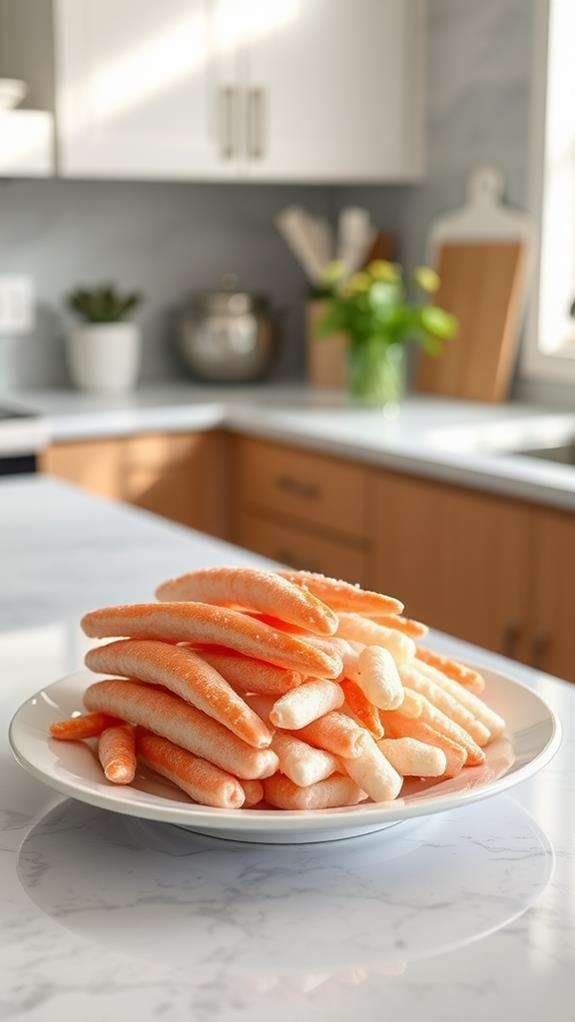
Surprisingly, imitation crab meat isn't crab at all – it's a processed seafood product made primarily from white-fleshed fish called surimi. You'll find that manufacturers typically use Alaskan pollock as the main fish, which they process into a paste and combine with starch, egg whites, artificial and natural flavors, and other additives to mimic real crab meat's texture and taste.
When you examine imitation crab closely, you'll notice it's often colored with carmine or paprika to achieve that distinctive pinkish-red hue that real crab meat displays. The product goes through several processing stages, including washing, grinding, and heating, to create its characteristic texture. You might recognize it in popular dishes like California rolls, seafood salads, or crab rangoon.
While it's marketed as a budget-friendly alternative to real crab meat, you should know that imitation crab contains considerably less protein and more carbohydrates than genuine crab. The product's official FDA name is "processed seafood," and you'll sometimes see it labeled as "krab," "crab stick," or "seafood stick" to distinguish it from authentic crab meat.
Proper Storage Guidelines
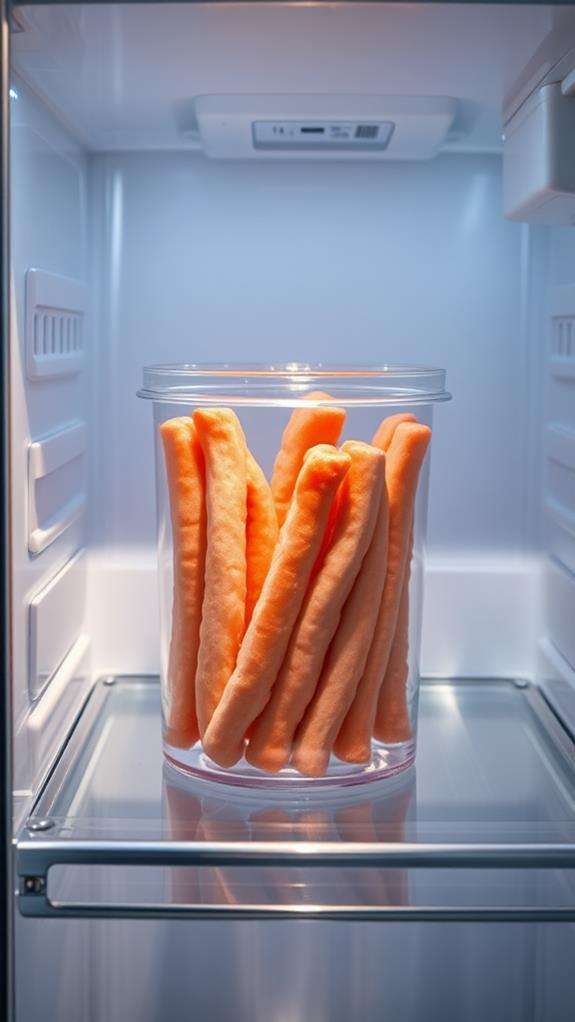
To maintain the quality of your imitation crab meat, following proper storage guidelines makes a significant difference in how long it stays fresh. You'll need to store your imitation crab in an airtight container or wrap it tightly in plastic wrap or aluminum foil, ensuring there's minimal exposure to air which can lead to bacterial growth and quality degradation.
Once you've opened the package, transfer any unused portions to your storage container right away, and don't let the product sit at room temperature for more than two hours. If you're dealing with unopened, vacuum-sealed packages, you can store them directly in your refrigerator's meat drawer, where the temperature remains consistently cold. Make sure your fridge maintains a temperature between 32°F and 38°F (0°C to 3°C) for ideal preservation.
When storing multiple packages, place them in a single layer rather than stacking them, as this helps maintain even cooling. If you've purchased bulk imitation crab, consider dividing it into smaller portions before storing, which allows you to thaw only what you need and reduces waste.
Shelf Life Time Frames
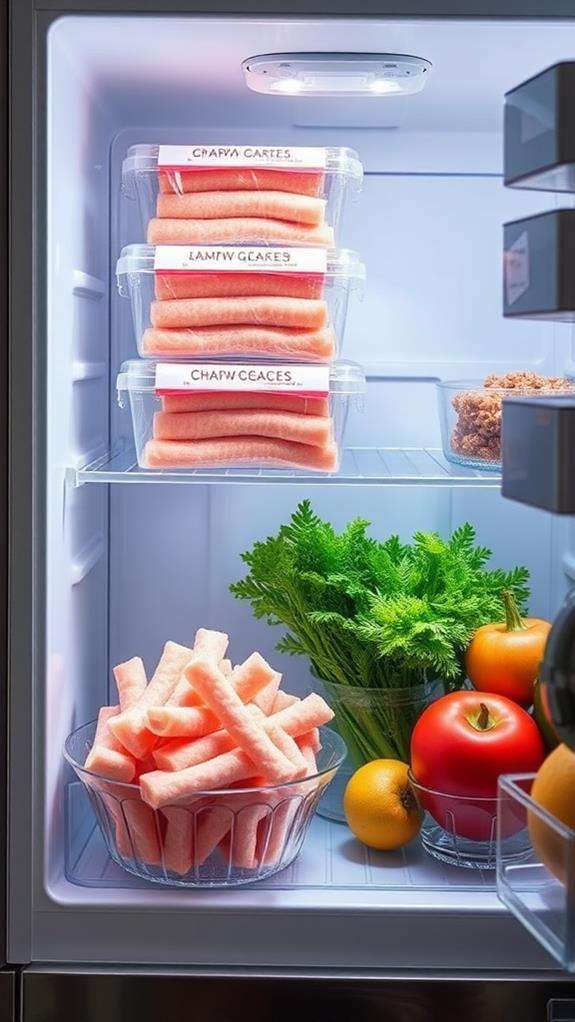
Knowing the precise shelf life of imitation crab will help you avoid food waste and prevent potential foodborne illness. When properly stored in your refrigerator at 40°F (4°C) or below, unopened imitation crab can last for up to 2 months past its "best by" date. However, once you've opened the package, you'll need to consume it within 3 to 5 days.
If you've purchased fresh imitation crab from the seafood counter, you should use it within 2-3 days of the purchase date. For prepackaged varieties that you've thawed from frozen, you'll want to use them within 4 days after thawing. It's essential to recognize that these timeframes assume you're following proper storage guidelines, including keeping the product in an airtight container or tightly wrapped in plastic wrap or aluminum foil.
Remember that these are general guidelines, and actual shelf life can vary depending on factors like temperature fluctuations in your refrigerator, how long the product was displayed before purchase, and whether it was continuously maintained at proper temperatures during transport and storage.
Signs of Spoilage

To spot spoiled imitation crab, you'll need to watch for key visual changes, including discoloration that turns from white or pink to dull gray, unusual dark spots, or any signs of mold growth. Your nose can be a reliable detector, as spoiled imitation crab will give off a distinctly sour, fishy, or ammonia-like odor that's noticeably different from its fresh state. When you touch the product, any slimy coating, unusually soft spots, or changes in texture from firm to mushy indicate it's time to discard the imitation crab immediately.
Visual Warning Signs
Visual inspection of your imitation crab can quickly reveal whether it's gone bad. When examining your imitation crab, you'll want to check for specific discoloration patterns and texture changes that indicate spoilage.
| Warning Sign | What It Means |
|---|---|
| Dull Color | Early stage of deterioration |
| Gray Spots | Bacterial growth beginning |
| Slimy Surface | Active decomposition |
If you notice the bright pink or red color has faded to a lackluster shade, it's the first indication that your imitation crab is starting to turn. You'll want to look carefully at the surface texture – any sticky or slimy coating means bacteria have begun breaking down the proteins. Don't ignore dark spots or discoloration, as these are clear signs of spoilage that can't be reversed.
The edges of your imitation crab should maintain their definition and shape. When you see the pieces starting to break down or become mushy, that's a strong indicator that they're no longer safe to eat. You should also watch for any fuzzy growth or unusual patterns on the surface, which indicate mold development.
Smell and Texture Changes
The smell and texture of imitation crab provide reliable indicators of its freshness. When you're checking imitation crab that's been stored in your fridge, pay close attention to any unusual odors. Fresh imitation crab should have a mild, slightly sweet seafood scent. If you detect any sour, fishy, or ammonia-like smells, it's time to discard the product.
The texture should remain firm and slightly springy when you touch it. As imitation crab begins to spoil, you'll notice it becoming slimy or developing a coating that feels sticky to the touch. The meat's surface might also become tacky or develop a filmy residue. If you've stored the imitation crab in its original packaging, watch for any excess moisture or liquid accumulating inside, as this can indicate breaking down of the product's structure.
The color should stay consistent with its original appearance – typically white with a pink or red exterior. If you notice any discoloration, particularly gray, yellow, or brown spots, or if the pink/red portions have faded considerably, these changes suggest the product has degraded and shouldn't be consumed.
Storage Container Options

Proper storage containers can greatly extend your imitation crab's shelf life. For best freshness, you'll want to choose airtight containers that prevent moisture and air from compromising the quality of your seafood. Glass containers with snap-on lids, BPA-free plastic containers, or heavy-duty resealable bags all work effectively for storing imitation crab.
If you're using the original packaging, you can keep the imitation crab in it, but make sure to wrap it tightly with plastic wrap or transfer any unused portions to a sealed container. For maximum protection, you might consider using vacuum-sealed bags, which remove all air and create an ideal storage environment. If you've purchased bulk imitation crab, consider dividing it into smaller portions before storing, which allows you to thaw only what you need.
Don't use containers that have lingering food odors or stains, as imitation crab can absorb these smells. Metal containers aren't recommended, as they can affect the taste and may react with the product's ingredients. Always label your storage container with the date of purchase or opening to track freshness effectively.
Freezing Imitation Crab
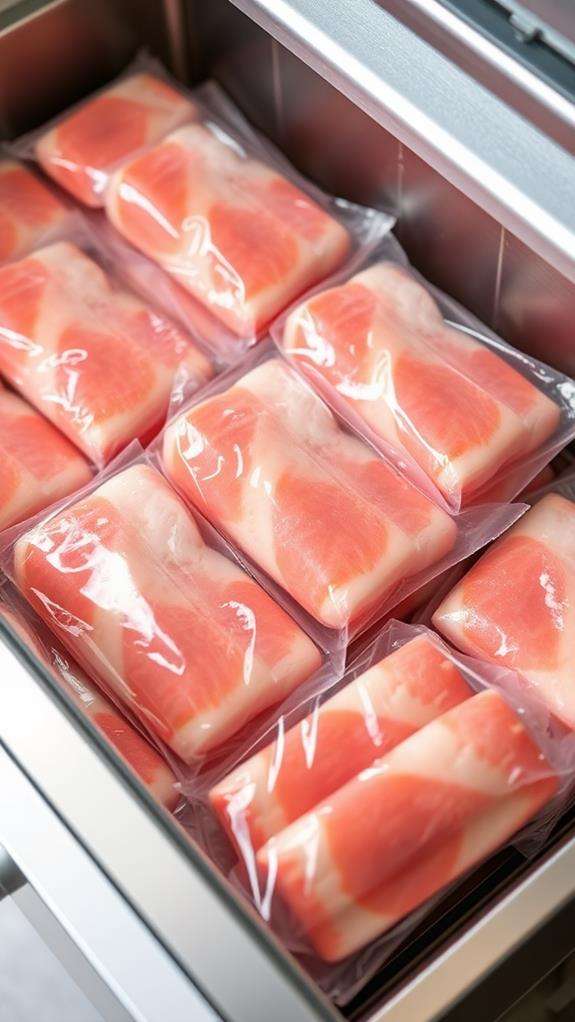
You'll need to wrap your imitation crab tightly in plastic wrap or place it in an airtight freezer bag, making sure to squeeze out as much air as possible before sealing to prevent freezer burn. When stored properly at 0°F (-18°C), your imitation crab meat can last up to six months in the freezer while maintaining its texture and flavor. For best results, write the freezing date on the package and try to use smaller portions that you can thaw as needed, since refreezing previously frozen imitation crab isn't recommended.
Proper Freezing Techniques
Freezing imitation crab properly can extend its shelf life up to 6 months, making it a smart option for long-term storage. You'll want to prepare your imitation crab carefully before freezing to maintain its quality and prevent freezer burn, which can greatly impact its taste and texture.
To guarantee the best results when freezing your imitation crab, follow these essential steps:
- Wrap individual portions tightly in plastic wrap, making sure to press out any air pockets that could lead to freezer burn or ice crystal formation.
- Place the wrapped portions in a freezer-safe container or heavy-duty freezer bag, removing as much air as possible before sealing.
- Label each package with the date of freezing and contents, allowing you to track freshness and rotate your stock effectively.
When you're ready to use your frozen imitation crab, transfer it to your refrigerator and let it thaw gradually for 24 hours. Don't thaw it at room temperature, as this can promote bacterial growth and compromise food safety. Once thawed, you should use the imitation crab within 3-4 days for the best quality and flavor.
Freezer Storage Time Limits
While following proper freezing techniques helps preserve your imitation crab, knowing the exact storage time limits is key to maintaining its quality. You'll want to keep track of when you first place the imitation crab in your freezer, as it typically maintains ideal quality for up to 6 months when stored at 0°F (-18°C) or below.
Though technically safe to eat beyond this timeframe, you'll notice the texture and flavor begin to deteriorate after the 6-month mark. To maximize your storage time, you should divide larger portions into smaller, meal-sized amounts before freezing. This approach not only helps maintain quality but also prevents unnecessary thawing and refreezing cycles. If you've purchased commercially frozen imitation crab, check the "best by" date on the package and add 3-4 months to that date for freezer storage.
Remember to label your packages with both the freezing date and contents. You'll need to consume thawed imitation crab within 3-4 days, so don't defrost more than you can use in that timeframe. For best results, rotate your frozen stock by using the oldest packages first.
Food Safety Best Practices
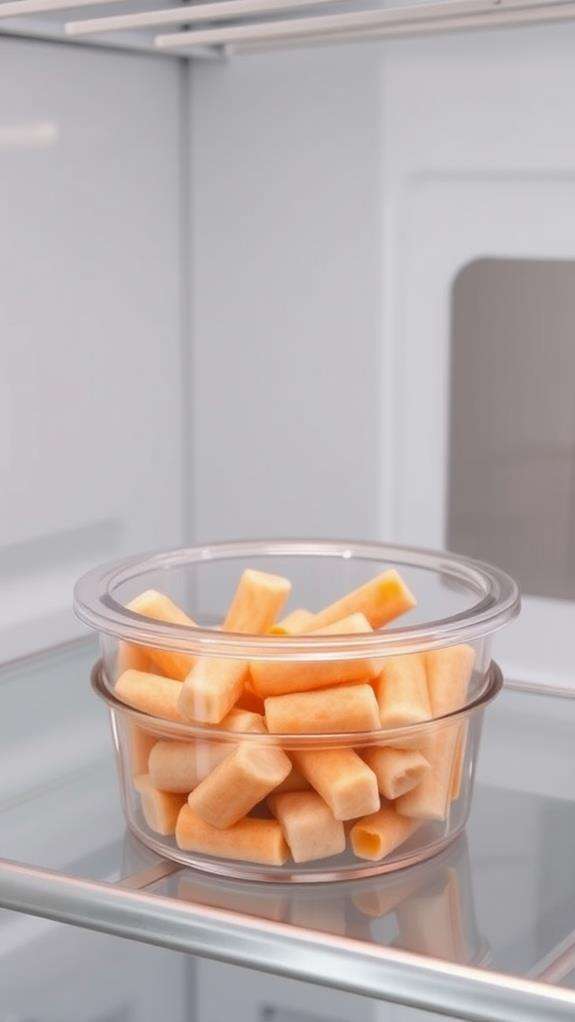
To guarantee your imitation crab meat stays safe to eat, following proper food safety practices is essential. You'll want to store your imitation crab in an airtight container or wrapped tightly in plastic wrap to prevent bacterial growth and cross-contamination with other foods. Always wash your hands thoroughly before handling the product, and make sure your refrigerator maintains a consistent temperature below 40°F (4°C).
When handling imitation crab, follow these critical safety guidelines:
- Never leave imitation crab at room temperature for more than 2 hours, or 1 hour if the ambient temperature exceeds 90°F (32°C)
- Use clean utensils and cutting boards when preparing the product, and wash them thoroughly between uses to prevent cross-contamination
- Check for signs of spoilage before consumption, including unusual odors, slimy texture, or discoloration
If you're serving imitation crab in a cold dish, keep it chilled using ice or refrigeration until just before serving. Don't mix old and new portions of imitation crab meat, as this can lead to faster spoilage and potential foodborne illness. When in doubt about the safety of your imitation crab, it's better to discard it than risk getting sick.
Thawing and Reheating Methods
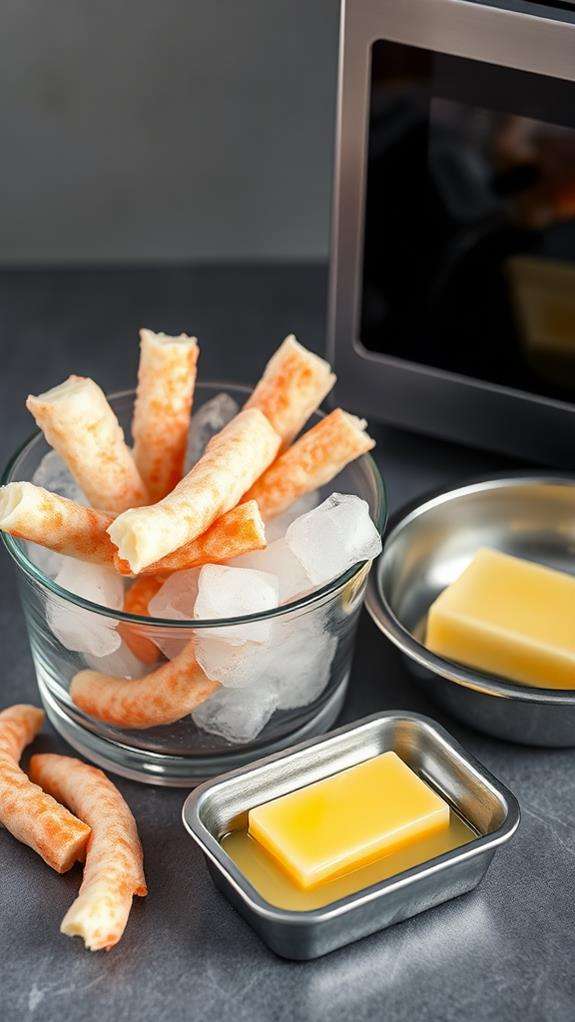
Safe thawing and reheating of imitation crab requires specific methods to maintain its quality and prevent bacterial growth. You'll want to thaw frozen imitation crab in the refrigerator, which typically takes 8-12 hours, rather than leaving it out at room temperature where bacteria can multiply rapidly.
When you're ready to reheat your imitation crab, you've got several effective methods at your disposal. The microwave works well for quick results – place the seafood in a microwave-safe dish, cover it with a damp paper towel, and heat in 20-30 second intervals until it reaches 165°F. If you prefer stovetop reheating, use a steamer basket over simmering water for 3-5 minutes, or sauté the pieces in a pan with a small amount of oil over medium heat. Don't forget to check the internal temperature with a food thermometer.
For best results, you shouldn't reheat imitation crab more than once, as each reheating cycle can degrade both texture and flavor. If you're incorporating it into hot dishes like casseroles or stir-fries, add the imitation crab near the end of cooking to prevent it from becoming tough or rubbery.
Frequently Asked Questions
Can Pregnant Women Safely Eat Imitation Crab?
Just like choosing the right ingredients for a perfect recipe, you'll want to be careful with imitation crab during pregnancy. While it's generally safe to eat, you should know it's made from processed fish called surimi. Since it's fully cooked, you don't need to worry about raw fish risks. However, you'll want to limit your portions due to its high sodium content and potential preservatives. Always check with your doctor about specific dietary restrictions.
Does Imitation Crab Contain Any Real Seafood Ingredients?
Yes, imitation crab typically contains some real seafood ingredients, primarily white-fleshed fish called surimi. You'll find that manufacturers use Alaska pollock most often, which they process and combine with starch, egg whites, and flavoring to mimic crab meat's taste and texture. While it's not actual crab meat, you're still consuming real fish protein when you eat imitation crab, though it's heavily processed and mixed with other ingredients.
How Many Calories Are in a Serving of Imitation Crab?
Like a gentle wave of relief for calorie-conscious seafood lovers, you'll find imitation crab meat relatively light on calories. A standard 3-ounce serving contains approximately 80-85 calories, which is lower than many protein alternatives. You'll get about 6 grams of protein, less than 1 gram of fat, and roughly 13 grams of carbohydrates in each serving. If you're watching your sodium intake, be aware that it can contain 300-400 mg per serving.
Can Dogs or Cats Eat Imitation Crab Meat?
You shouldn't feed imitation crab to your pets. While it's not toxic, imitation crab contains artificial flavors, preservatives, and high sodium levels that aren't good for dogs or cats. It's also made with processed fish protein (surimi) and starches that can be hard for pets to digest. If you want to treat your pet to seafood, it's better to give them small amounts of plain, cooked real fish instead.
Is Imitation Crab Suitable for People With Shellfish Allergies?
Even if you have a shellfish allergy, you shouldn't assume imitation crab is safe to eat. While it's primarily made from white fish (usually pollock), many brands contain real crab extract or shellfish flavoring for taste. There's also a risk of cross-contamination during processing. To be safe, you'll want to check ingredient labels carefully and consult your doctor before trying imitation crab if you've got shellfish allergies.





